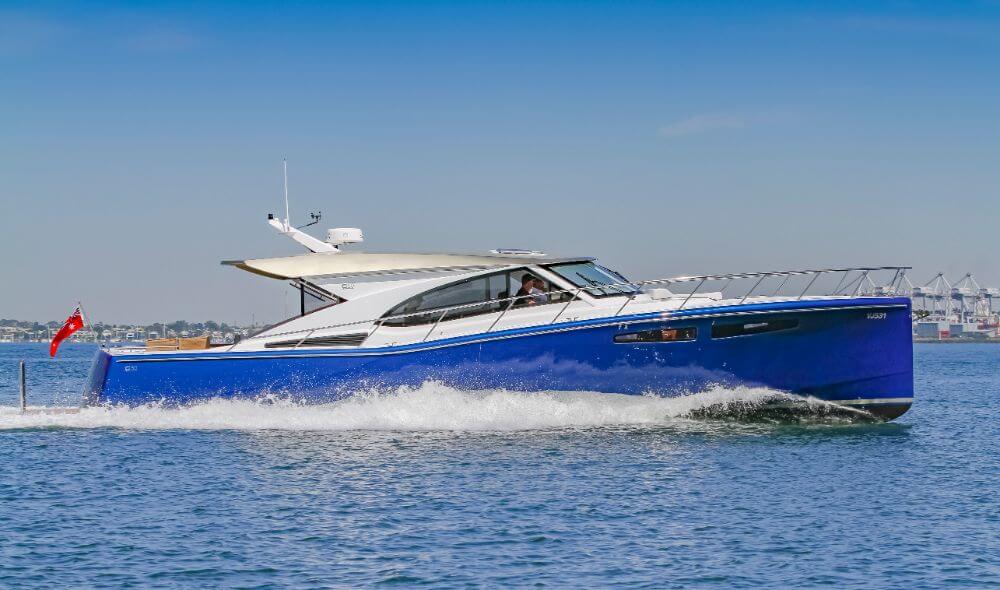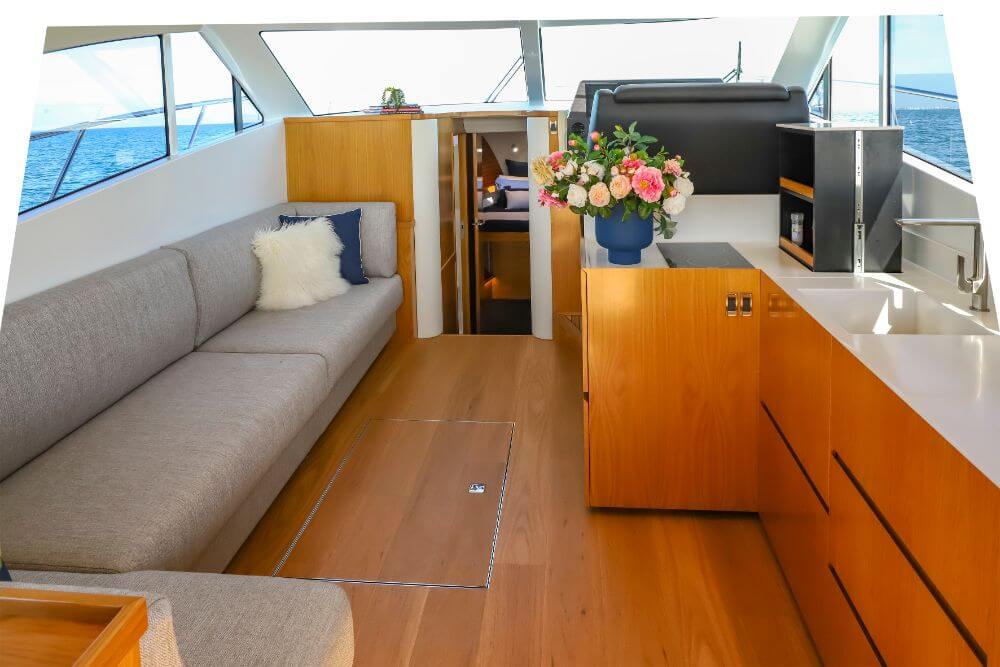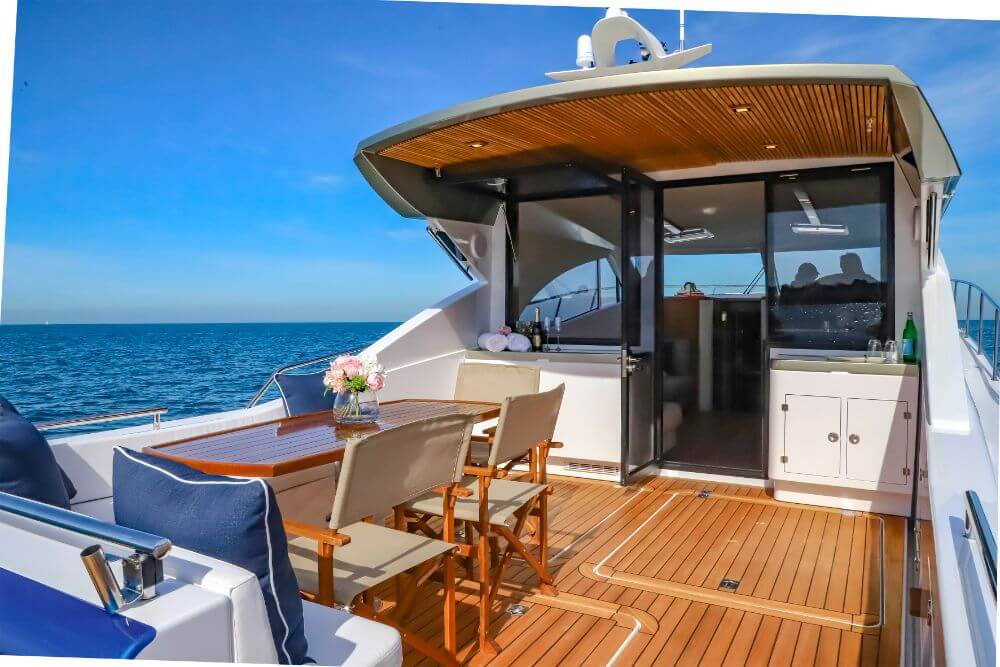Author: John Willis
Photography: John Willis, Chris Beattie, Jack Beattie
STUNNING DEBUT
The quality and performance of the Cape50 bodes well for this first entry into the competitive luxury cruiser market.
Passion, it’s infectious and can drive the quest for excellence. Melbourne’s Steve Campbell has passion. In spades. The master shipwright has some 30 years of hands-on experience and has applied his considerable nautical talents, via his company Composites Constructions, to produce the stunning new Cape50, a motor yacht built with the latest state-of-the-art processes and composite materials.
The Cape50 exudes style, Steve managing to blend timeless seafaring tradition with contemporary nautical chic, and then throwing in some modern Nordic design and Euro flair to create an enchanting cruiser that loves to entertain and get up and boogie like a rock star.
The Cape50 has elements of a traditional Maine lobster boat with its blunt stem and tumble-home transom, but it’s interwoven with the latest European trends in slender, full-chine hulls with a steep flared entry. She has a sweeping Carolina-style sheer line with big, high shoulders that straightens as it flows into the long and inviting rear deck. Her cabin lines, mouldings and windows, combined with a gorgeous colour palate, enhance the overall aesthetic. Add to it the latest power, drive, electronics, accessories and furnishing, and the result is simply drop-dead gorgeous.
“When you’re a 30-year master shipwright, you know how to plan well, select the best people and materials, and then you and your team can craft something special – that ‘later in life child’, if you like,” explained Steve. “It takes time, but you know and believe in yourself, your team and your craft. It’s 100 per cent effort and accuracy all of the time, or not at all.”
While the final design is his own, Steve worked with naval architects and premium suppliers to perfect the concept, including the use of premium paints, and a warm and friendly interior and cockpit with highlights of teak and American ash.

FUTURISTIC CONSTRUCTION
It may have traditional styling, but the construction is futuristic. The hull, deck and all bulkheads are vacuum resin-infused foam sandwich, maximising the inherent strength while reducing weight. Steve has many years of experience creating and developing racing yachts and is a leader in such technologies. The beautiful metallic finishes are Awlcraft Xeon Blue on the hull and champagne gold on the saloon roof, with polar white inserts between. The aesthetics are enhanced with a strong 32mm 316-grade marine stainless-steel bow and side rails offset by black window frames.
The Cape50 has a spacious and efficient blend of outdoor and indoor spaces, which include a teak-laid cockpit and a rear platform, an inviting saloon and twin-stateroom accommodation. Whether it is an evening soirée, beachside parking for the gang, a quiet brunch in a secluded backwater or maybe a spot of fishing, the cockpit is roomy enough for all activities.

Combine it with the large rear platform, rear door, folding boarding ladder and a concealed barbecue on the outer transom, plus the sunlounge on the foredeck, and you could host a party for a cricket team.
The cockpit also features an L-shaped rear lounge, moulded chest fridge, and a utility/utensils cabinet, and is finished with superb natural teak, including a most attractive display as a head liner under the substantial roof awning that provides plenty of shade. Our review boat had a portable timber table and folding chairs to create an ideal dining or entertaining setting. Underfloor are three large hatches providing easy access to the engine bays and Volvo Penta IPS drives.
The Cape50 flows beautifully from deck to saloon, with a large door and café-style windows bringing the outside in, and the inside out.

INVITING
I find the saloon’s inviting and uncluttered layout exceptionally appealing. There’s plenty of natural light and visibility from the array of windows and the large, two-piece curved windscreen. There’s even a pair of electric vent windows for the driver and passenger.
The port side features a long L-shaped lounge furnished in stylish, yet hard-wearing linen from Warwick Fabrics. Underneath we find plenty of general storage. To starboard is the helm up in front, with galley behind, all displayed in a refreshing array of surfaces including American ash laminates with Corian benchtops, faux timber floor, white upholstered head liners, black leather cross-stitched helmsman seat and trims, with some carbonfibre features and premium fixtures and fittings.
I simply loved that the galley shows true nautical intent, including neatly raised edges to prevent spillage off the benchtops. There’s plenty of flat surface for preparation, plus a deep sink with hot/cold mixer and a flush-mounted two-burner induction cooktop. Features also include a very handy pop-up pantry in the corner behind the helm seat, and a large 44in pop-up television in the rear corner of the saloon. There’s a 120lt Isotherm fridge beneath the helm module, and a microwave and plenty of utensil drawers in the stylish cabinetry.
The helm’s high dash still allows plenty of forward vision, especially considering the nature of the minimal-deadrise hull design matched with pod drives that create very little bow rise on acceleration, which is easily compensated for with Zipwake trim tabs.
Twin Garmin 16in multifunction screens dominate the dash and are linked to the sounder, radar, autopilot, engines and CZone digital networking, integrating full boat control and diagnostics. The helm has a sporty leather-cloaked steering wheel and the joystick controls, while the neat console houses a Fusion sound system, Garmin VHF, a micro-touch switch panel for the window actuators, the anchor winch and other ancillaries.

SPARE THE STAIRS
One thing I love about saloon-style boats is the lack of stairs. Step down just two stairs in the forward companionway and you find the bathroom to port, with the master stateroom up in the bow, and the guest/kids quarters on your right. The accommodation might not be that elaborate, but it’s a great example of the alluring lobster boat theme – it’s very comfortable, inviting and stylish, boasting an attractive array of timber veneers, lush upholstery, neat headliners and teak trims.
The bathroom is very neat and reasonably roomy with a fully moulded white capsule, Planus Artic electric toilet, a good array of mirror-fronted overheads, an ebony carbon fibre benchtop with matching basin, stylish tapware and fittings, plus a reasonably large separate shower with seat and teak features.
The master features a queen-sized island bed with pillow-top mattress. Underneath is drawer storage to the front and a cavity in the bow. There’s a 30in TV and entertainment system, two wardrobes, and a good array of lighting options. The crew quarters has an extended single at the base with a smaller bunk on top, wardrobes and storage options, and an overhead ventilation hatch.
A Kolher 11kVa generator and shore power keeps all systems well-powered, including the 10,000 BTU air-conditioning in the cabins and 16,000 BTU in the saloon. Other electronic features include a Lewmar electric windlass, Hella LED marine lighting for both the interior and exterior, Isotherm water heater, BEP DC/240 switchboard, Mastervolt AC/DC power system (with option for solar backup), Aqualuma underwater lights, electric barbecue, and plenty of USB and 240V outlets throughout.

BUILT LIGHT AND RIGHT
The Cape50’s LOA is 15.2m, with a waterline of 14.5m and a 4.3m beam. Fuel is carried in twin 800lt tanks, with 600lt of water and a 200lt black-water tank. The Cape50’s relative light dry weight of 12,500kg, fitted with twin 440hp Volvo Penta D6 IPS600s, is testimony to the infused-resin technology and choice of strong, yet lightweight synthetics utilised throughout the construction.
And she goes as well as she looks. The hull rockets out of the hole with minimal discernible transition to plane – this is one of the quietest running hulls of its type that I have tested. Performance is exceptionally sporty, especially for a 15m boat with a strong and seaworthy attitude.
We had a belly full of fuel and bit of load on our test day, but still achieved 33.5 knot performance, however Steve guarantees he has seen 35 knots. Consumption at 33.5 knots was 168lt/h at 3540rpm.
The ride felt extremely solid, with no impact or jarring even in the small head sea. The boat planes at a low 16.5 knots at 2000rpm using 43lt/h, but feels exceptional at a speedy cruise at 22 knots at 2500rpm using 70lt/h (that’s a whopping 452nm range with 10 per cent in reserve). A fast 27 knots at 2930rpm uses 106lt/h, which is still very economical for the size and power.
To be honest, I just can’t speak highly enough of the Cape50 – she’s sleek, stylish and built for entertaining. As a first effort for such a demanding and competitive segment of the market, this boat is simply stunning.

SPECIFICATIONS
- Design Name: Cape50
- Year Launched: 2020
- Builder: Composites Constructions
- Designer: Steve Campbell
- LOA: 15.24m
- Beam: 4.30m
- Displ (Loaded): 15,500kg
- Max Speed: 29 knots
- Construction: Composite
- Fuel Cap: 1600 litres
- Water Cap: 600 litres
- Engines: 2 x 440hp Volvo Penta D6 IPS600
- Drive Train: IPS
- Priced from: AUD$1.3m (approx.)
- Price as tested: AUD$1.6m (approx.)




